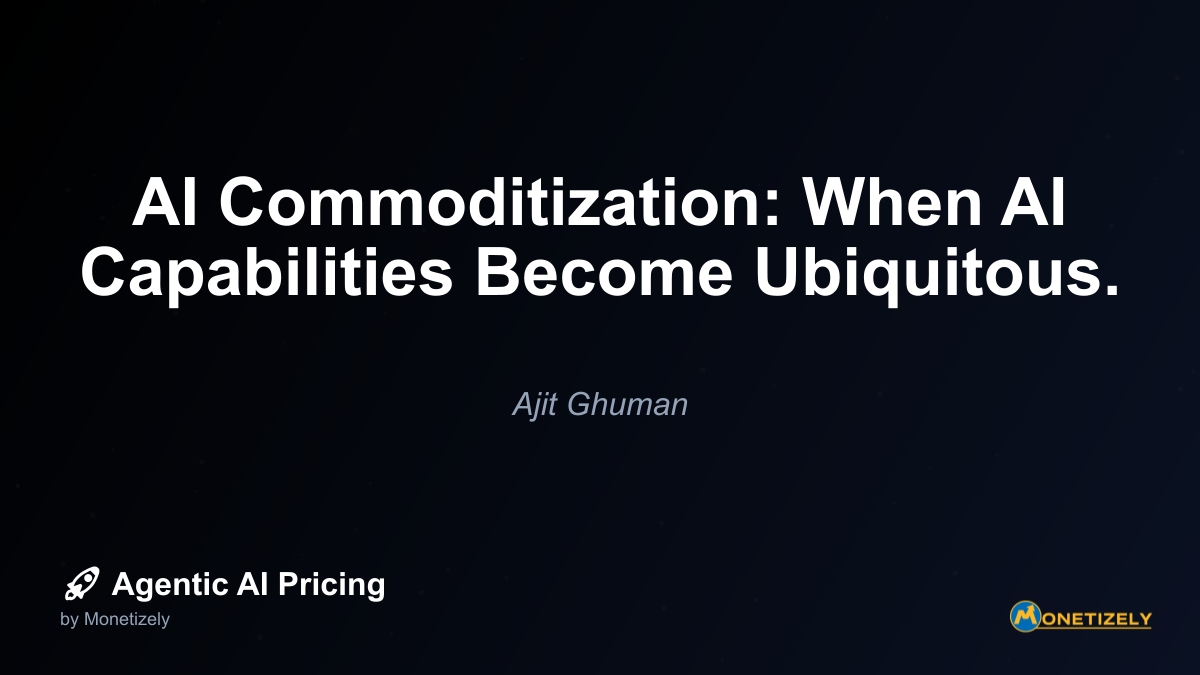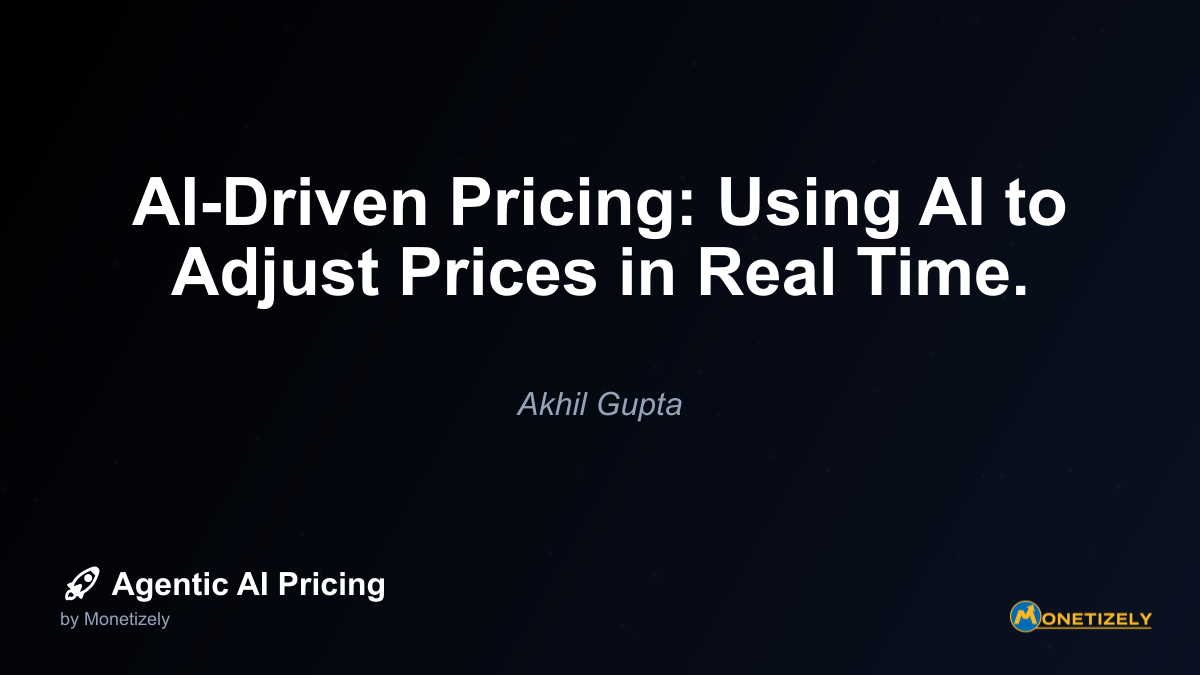· Akhil Gupta · Emerging Trends · 6 min read
Industry Collaboration: Moving Toward Pricing Best-Practice Consortia.
AI and SaaS Pricing Masterclass
Learn the art of strategic pricing directly from industry experts. Our comprehensive course provides frameworks and methodologies for optimizing your pricing strategy in the evolving AI landscape. Earn a professional certification that can be imported directly to your LinkedIn profile.

Benefits of Standardized Approaches
The potential advantages of industry-wide pricing collaboration extend to all stakeholders:
For Providers:
Reduced Market Education Costs: When customers understand standard pricing structures, companies spend less explaining basic concepts and more demonstrating unique value.
Accelerated Sales Cycles: Standardization simplifies procurement processes, reducing friction in the buying journey.
More Accurate Forecasting: Common industry metrics enable better benchmarking and financial planning.
Efficient Resource Allocation: Companies can focus innovation on differentiation rather than reinventing pricing fundamentals.
For Customers:
Simplified Comparison Shopping: Standard metrics make it easier to evaluate competing offerings.
Reduced Procurement Complexity: Standardized terms streamline contract negotiations and approval processes.
Better Budget Planning: Consistent pricing structures improve forecasting accuracy for AI expenditures.
Increased Confidence: Industry standards signal market maturity, reducing perceived risk in adoption decisions.
For the Broader Ecosystem:
Accelerated Market Growth: Reduced friction accelerates overall adoption rates.
Improved Trust: Transparency and consistency build confidence in AI technologies.
More Equitable Access: Standardization can promote wider access across organization sizes and sectors.
Regulatory Alignment: Proactive industry standards may preempt more restrictive regulatory interventions.
Real-World Progress Toward Collaborative Pricing
While full industry standardization remains aspirational, several initiatives demonstrate momentum toward collaborative approaches:
The Enterprise AI Pricing Coalition
Launched in early 2023, this group of enterprise software providers has developed a “Transparency Pledge” committing to clear disclosure of AI pricing components, including:
- Computational resource measurement
- Data usage accounting
- Model training costs
- Support and maintenance boundaries
While not dictating specific pricing levels, the pledge establishes common disclosure practices that help customers make informed comparisons.
The Open AI Pricing Project
This open-source initiative is developing standardized pricing calculators and reference models that companies can adapt to their specific offerings. The project has attracted contributions from both established providers and startups seeking to establish credible pricing frameworks.
Industry Analyst Standardization
Major analyst firms have begun developing standardized evaluation frameworks for AI pricing models, creating external pressure for convergence around common approaches. These frameworks are increasingly influential in enterprise purchasing decisions.
Cloud Provider Templates
Leading cloud platforms have introduced AI pricing templates that third-party developers can adopt, potentially establishing de facto standards through ecosystem influence.
Challenges and Limitations to Collaborative Approaches
Despite promising developments, several obstacles complicate industry-wide pricing collaboration:
Competitive Differentiation Concerns
Companies may resist standardization if they view their pricing approach as a competitive advantage or if they’ve invested heavily in proprietary pricing methodologies.
Antitrust Considerations
Any industry collaboration on pricing requires careful legal structuring to avoid anticompetitive implications. This typically means focusing on structural elements rather than specific price points.
Technical Complexity
The multidimensional nature of AI costs makes standardization technically challenging, particularly as capabilities continue evolving rapidly.
Market Power Imbalances
Dominant players may resist standards that reduce barriers to entry or comparison shopping that might benefit smaller competitors.
Global Variations
Different regional markets may require distinct approaches, complicating global standardization efforts.
The Path Forward: A Graduated Approach
Given these complexities, the most viable path forward appears to be a graduated approach to pricing collaboration:
Phase 1: Common Terminology and Metrics
The industry first establishes shared definitions and measurement standards without dictating structure or levels. This creates a common language for the market.
Phase 2: Voluntary Disclosure Standards
Companies adopt consistent disclosure practices that make pricing components transparent, even if the structures themselves remain diverse.
Phase 3: Reference Architectures
The industry develops recommended pricing frameworks that companies can adopt or adapt, creating “families” of related approaches.
Phase 4: Standardized Segments
Certain market segments, particularly commodity-like services, may evolve toward more standardized pricing, while specialized offerings maintain greater differentiation.
How Companies Should Prepare
As the industry moves toward greater pricing collaboration, forward-thinking organizations should take several preparatory steps:
1. Audit Current Pricing Approaches
Evaluate how your existing pricing models align with emerging industry patterns and where proprietary approaches create value versus confusion.
2. Engage in Collaborative Initiatives
Participate in industry groups developing standards to ensure your perspective influences outcomes rather than merely reacting to them.
3. Develop Modular Pricing Structures
Design pricing architectures that can incorporate standardized elements while preserving unique value propositions.
4. Invest in Pricing Communication
Develop clear explanations of how your pricing relates to emerging standards, highlighting both alignment and intentional differentiation.
5. Monitor Competitive Response
Track how competitors position themselves relative to collaborative standards, identifying opportunities to lead or differentiate.
The Role of AI in Facilitating Standardization
Ironically, AI itself may accelerate pricing standardization through:
Automated Pricing Comparison Tools
AI-powered tools that translate between different pricing models are already emerging, creating de facto standardization through interpretation layers.
Dynamic Pricing Optimization
AI systems that continuously optimize pricing based on market conditions may naturally converge around common approaches as they identify efficient patterns.
Natural Language Interfaces
As conversational AI becomes the primary way customers interact with pricing information, these interfaces may standardize how pricing is explained and understood.
Conclusion: The Inevitable Evolution Toward Collaboration
The current fragmentation in AI pricing is likely a temporary phase in the market’s evolution. Historical patterns across technology sectors suggest that as markets mature, they typically develop more standardized approaches to pricing—whether through formal collaboration, market forces, or regulatory pressure.
For agentic AI specifically, the combination of technical complexity, rapid evolution, and trust considerations creates a compelling case for collaborative approaches that benefit all stakeholders. While full standardization remains unlikely and potentially undesirable, increased coordination on fundamental pricing elements appears both inevitable and beneficial.
Forward-thinking companies will recognize this trajectory and position themselves to influence and benefit from emerging standards rather than resist them. By participating in collaborative initiatives while maintaining distinctive value propositions, providers can help create a more functional market that accelerates overall adoption while preserving healthy competition.
The question is not whether the industry will move toward more standardized pricing approaches, but how quickly and through what mechanisms. Companies that proactively engage with this trend will likely gain advantage over those that cling to entirely proprietary approaches in a market increasingly seeking clarity, comparability, and trust.
As one industry executive recently observed: “The winners in AI won’t be those who create the most unique pricing models—they’ll be those who create the most value while making it easiest for customers to understand and access that value. Sometimes that means agreeing on the rules of the game so we can focus on playing it better than anyone else.”
For organizations navigating the complex AI pricing landscape, participation in emerging collaborative frameworks represents not just good citizenship but strategic positioning in a market evolving toward greater standardization. The time to engage is now, while the frameworks themselves are still being shaped by early participants.
In the coming years, we can expect to see the emergence of AI pricing standards that balance clarity with flexibility, creating a more functional marketplace that accelerates adoption while preserving innovation. Those who help build these standards will have the greatest influence on their final form—and potentially the greatest advantage in the market they create.
Co-Founder & COO
Akhil is an Engineering leader with over 16+ years of experience in building, managing and scaling web-scale, high throughput enterprise applications and teams. He has worked with and led technology teams at FabAlley, BuildSupply and Healthians. He is a graduate from Delhi College of Engineering and UC Berkeley certified CTO.
Pricing Strategy Audit
Let our experts analyze your current pricing strategy and identify opportunities for improvement. Our data-driven assessment will help you unlock untapped revenue potential and optimize your AI pricing approach.




